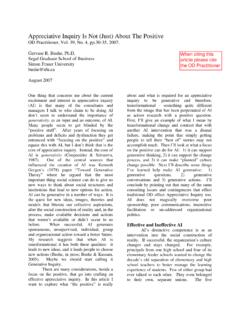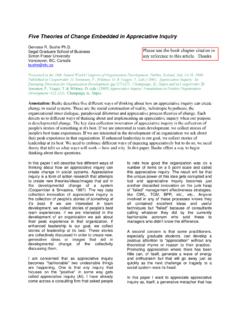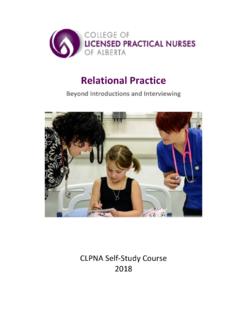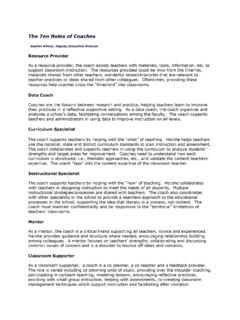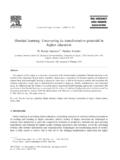Transcription of When Is Appreciative Inquiry Transformational?
1 JOURNAL OF APPLIED BEHAVIORAL SCIENCEJune 2005 Bushe, Kassam / Appreciative INQUIRYWhen Is Appreciative Inquiry Transformational? A Meta-Case AnalysisGervase R. BusheSimon Fraser University, CanadaAniq F. KassamBlast Radius, CanadaTwenty cases of the use of Appreciative Inquiry (AI) for changing social systems pub-lished before 2003 were examined to look for the presence or absence of transformationalchange and the use of seven principles and practices culled from a review ofthe theoreti-cal literature on AI. Although all cases began by collecting stories of thepositive, fol-lowed the 4-D model, and adhered to five principles of AI articulated by Cooperrider andWhitney, only seven (35%) showed transformational outcomes.
2 Highly consistent differ-ences between the transformational cases and the others led the authors toconclude thattwo qualities of Appreciative Inquiry that are different from conventional organizationaldevelopment and change management prescriptions are key to AI s transformativepotential: (a) a focus on changing how people think instead of what people do and (b) afocus on supporting self-organizing change processes that flow from new :organizational change; organizational development; Appreciative inquiryAll indications are that Appreciative Inquiry (AI) is an increasingly popular organiza-tional change method, but an almost complete lack of published research exists exam-ining it. Only two attempts to measure its impact exist in the research literature (Bushe161 Gervase R.)
3 Bushe, , is director of the MBA in Leadership and Organizational Change and an associateprofessor of management and organization studies in the Faculty of Business Administration at Simon Fra-ser University, Burnaby, F. Kassam, BBA, was a business student at Simon Fraser University whenthis study was completed andis currently alliances manager at Blast Radius, a software firm in Vancouver, JOURNAL OF APPLIED BEHAVIORAL SCIENCE, Vol. 41 No. 2, June 2005 161-181 DOI: 2005 NTL Institute& Coetzer, 1995; Jones, 1998), and the first was at the group level. Yet, thepast few yearshave seen an exponential growth in the number of consultants and organizations usingAI, the number of graduate theses in organization development that use an AI approach,and the number of practitioner articles and books describing it.
4 Between 1987, whenthe original seminal article on AI was first published (Cooperrider & Srivastva, 1987)and 2000, only a handful of articles the rather sparse, self-published Thin Book (Hammond, 1996) and fairly primitive Lessons From the Field (Hammond & Royal,1998) existed. In 1999, Cooperrider finally published a short book on howto doappreciative Inquiry (Cooperrider & Whitney, 1999), and Elliott (1999) published thefirst serious, scholarly book on applications of AI in the 2001, things have changed considerably. Five significant AI books have beenpublished (Cooperrider, Sorensen, Whitney, & Yeager, 2001; Fry, Barrett, Seiling, &Whitney, 2002; Ludema, Whitney, Mohr, & Griffen, 2003; Watkins & Mohr, 2001;Whitney & Trosten-Bloom, 2003).
5 Elsevier and Jossey-Bass have each launched aseparate series of books on AI. A global consulting firm, AI Consulting, that, accord-ing to their Web site at the time of this writing had 97 members, was launchedin of the largest consulting firms in the world, Cap Gemini Ernst Young, hasdeclared that AI is the core of their human systems consulting practice. The first inter-national conference on AI was held in Baltimore just weeks after 9/11, and still close to600 people flew in from all over the world to attend. Ludema et al. (2003) list morethan 75 businesses, nonprofit organizations, governments, and communities that haveengaged in significant AIs, and this is just from their personal experience. Even Navy is in the game, having created a center for positive change that isleadingmultiple AIs.
6 Robert Quinn (2000) of the University of Michigan recently wrote that Appreciative Inquiry is currently revolutionizing the field of organizationdevelopment (p. 220).What this indicates is that the practice of AI is in a time of exponential growth. Thisis usually a dangerous time for innovations in organizational change and developmentpractice as the fad phenomenon sets in (Collins, 2000, 2003; Miller & Hartwick,2002). In this article, we examine just what is going on in the practice of AIand theextent to which AI practice and outcomes match the prescriptions of AI theorists. Wedo this by systematically examining every published case study of AI we could findprior to 2003 and assess them against a set of criteria we developed from reviewing theleading prescriptions of AI theory and practice prior to 2003 (Barrett & Cooperrider,1990; Bushe 1995, 2001b; Cooperrider, Barrett, & Srivastva, 1995; Cooperrider &Srivastva, 1987; Cooperrider & Whitney, 1999, 2001; Fry & Barrett, 2002; Ludema,2002; Ludema, Wilmot, & Srivastva, 1997; Watkins & Mohr, 2001).
7 We begin byidentifying the kinds of transformational outcomes that AI theorists claim for AI thatmake AI new and different from other change processes. We focus on transformationalchange as this is the most ambitious claim any change process can make and isoneoften made by transformation we are referring to changes in the identity of a system and quali-tative changes in the state of being of that system. Such changes have been variouslydefined as second-order change (Watzlawick, Weakland, & Fisch, 1974), radicalchange (Nord & Tucker, 1987), and revolutionary change (Romanelli & Tushman,162 THE JOURNAL OF APPLIED BEHAVIORAL SCIENCEJune 20051994) and contrasted with changes to a system that keep the basic nature of the systemintact.
8 The principles and processes that AI theorists propose lead to positive organiza-tional transformation are identified. This list is compared to the set of published casesthat results in a matrix that identifies, for each case, the extent to whichthese outcomesand processes occurred. Patterns emerge from this analysis that we discuss in our find-ings. In essence, we find that those cases describing transformational outcomes alsodescribe processes that are consistent with AI theorists and that are somewhat differentfrom conventional organizational development (OD) practice. Those cases that do notshow transformational outcomes look more like successful, conventionalactionresearch efforts guided by Inquiry into the positive that is, the best of system mem-bers experiences and aspirations resulting in useful first-order Outcomes Claimed by AIIn examining the literature of AI we find two specific outcome claims of AI that dis-tinguish it from other OD interventions.
9 They are somewhat first isthat AI results in new knowledge, models, and/or theories. The second is that AIresults in a generative metaphor that compels new claim to generating new knowledge (models, theories) is perhaps the mostimportant claim of the theory of Appreciative Inquiry as a method of and Srivastva (1987) focus their critique on traditional action researchand problem-solving approaches to planned change primarily by arguing that they donot lead to new knowledge but instead to (re)creating the processes they claim to bestudying. They point out that action research has not been very successfulat creatingnew models and theories of social organization and that most action research as prac-ticed by OD consultants begins with a model of the ideal group or organization that itthen assesses the system against.
10 They state that AI emerged out of a searchfor meth-ods of Inquiry that have the potential to create new images, models, and theories ofsocial organization. In their article, they convincingly argue that the most powerfulforce for change in social systems is a new idea and offer AI as a method of Inquiry forgenerating new compare AI with OD, one is forced to construct what OD is, assured that in prac-tice, there is an exception to any general rule; but what gets written in thepapers andtextbooks is more homogenous. The culture of OD emerged out of the science of psy-chology of the 1940s, which focused on behavior because that is what could be mea-sured. In the core of the OD literature, there is very little focus on changing how peoplethink and more on changing what people do how they work together, communicate,solve problems, manage conflicts, and learn.


